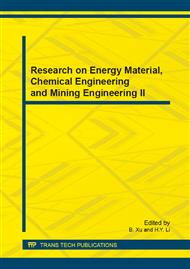[1]
Beg Q.K., Kapoor M., Mahajan L. and Hoondal G. S., Microbial xylanases and their industrial applications: a review [J]. Appl. Microbiol. Biotechnol., 2001, 56(3): 326-338.
DOI: 10.1007/s002530100704
Google Scholar
[2]
Rasmussen L.E., Sorensen H.R., Vind J.J. and Vikso-Nielsen A., Mode of action and properties of the β–xylosidase from Taleromyces emersonii and Trichoderma ressei [J], Biotechnol. Bioeng., 2006, 94(5): 869-876.
DOI: 10.1002/bit.20908
Google Scholar
[3]
Collins T., Gerday C. and Feller G., Xylanases, xylanase families and extre mophilic xylanases [J], FEMS Microbiol. Rev., 2005, 29(1): 3-23.
DOI: 10.1016/j.femsre.2004.06.005
Google Scholar
[4]
Khandeparker R. and Numan M.T., Bifunctional xylanases and their potential use in biotechnology [J], J. Ind. Microbiol. Biotechnol., 2008, 35(7): 635-644.
DOI: 10.1007/s10295-008-0342-9
Google Scholar
[5]
Courtin C.W. and Delcour J.A., Arabinoxylans and endoxylanases in wheat flour bread-making [J], J. Cereal Sci., 2002, 35(3): 225–243.
DOI: 10.1006/jcrs.2001.0433
Google Scholar
[6]
Liu M.Q. and Liu G.F., Expression of recombinant Bacillus licheniformis xylanase A in Pichia pastoris and xylooligosaccharides released from xylans by it [J], Protein Expr. Purif., 2008, 57(2): 101-107.
DOI: 10.1016/j.pep.2007.10.020
Google Scholar
[7]
Vikari L., Kantelinen A., Sundquist J. and Linko M., Xylanasee in bleaching: from an idea to the industry [J], FEMS Microbiol. Rev., 1994, 13(2): 335–350.
DOI: 10.1111/j.1574-6976.1994.tb00053.x
Google Scholar
[8]
Jeffries T.W. and Jin Y.S., Ethanol and thermotolerance in the bioconversion of xylose by yeasts [J], Adv. Appl. Microbiol., 2000, 47: 221-268.
DOI: 10.1016/s0065-2164(00)47006-1
Google Scholar
[9]
Dhiman S.S., Sharma J. and Battan B., Industrial Applications and Future prospects of Microbial Xylanases: a review [J], Bioresources, 2008, 3: 1377-1402.
Google Scholar
[10]
Kinoshita K., Takano M., Koseki T., Ito K. and Iwano K., Cloning of the xynNB gene encoding xylanase B from Aspergillus niger and its expression in Aspergillus kawachii [J], J. Ferment. Bioeng., 1995, 79(5): 422–428.
DOI: 10.1016/0922-338x(95)91255-4
Google Scholar
[11]
Wong K.K.Y. and Saddler J.N., Trichoderma xylanases, their properties and application [J], Crit. Rev. Biotechnol., 1992, 12(5): 413–435.
Google Scholar
[12]
Bailey M.J., Puls J. and Poutanen K., Purification and properties of two xylanases from Aspergillus oryzae [J], Biotechnol. Appl. Biochem., 1991, 13: 380–389.
Google Scholar
[13]
Ahmed S., Riaz S. and Jamil A., Molecular cloning of fungal xylanases: an overview [J], Appl. Environ. Microbiol., 2009, 84(1): 19–35.
DOI: 10.1007/s00253-009-2079-4
Google Scholar
[14]
Li F., Zhao L.G., Li G.Q., Yang S.Y., Li X. and Wang F., Cloning, expression and characterization of xylanase gene XYNB from Aspergillus niger in Pichia pastoris, 4th International Symposium on Emerging Technologies of Pulping and Papermaking, Guangzhou, China, 2010, 637-640.
DOI: 10.15376/biores.7.2.2330-2343
Google Scholar
[15]
Zhang W.H., Inan M. and Meagher M.M., Fermentation strategies for recombinant protein expression in the methylotrophic yeast Pichia pastoris [J], Biotechnol. Bioprocess Eng., 2000, 5: 275-287.
DOI: 10.1007/bf02942184
Google Scholar


